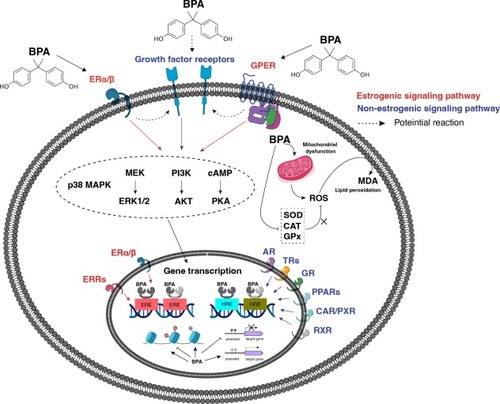Fig. 3
- ID
- ZDB-FIG-231102-68
- Publication
- Yuan et al., 2023 - Estrogenic and non-estrogenic effects of bisphenol A and its action mechanism in the zebrafish model: An overview of the past two decades of work
- Other Figures
- All Figure Page
- Back to All Figure Page
|
Schematic diagram shows the estrogen-only (red line), non-estrogen-only (blue line), and both estrogenic and non-estrogenic signaling pathways of BPA (black line) that have been studied in the zebrafish. 1) The estrogenic activities of BPA showed that BPA can bind with ERα/β and GPER on the cellular membrane, in which co-acting with the growth factor receptors, and bind with ERα/β, GPER and ERRs on the nuclear membrane to induce their subsequent signaling pathways and regulate estrogenic BPA-target gene expression. 2) The non-estrogenic activities of BPA showed that BPA can bind with growth factor receptors on the cellular membrane, and bind with AR, TRs, GR, PPARs, CAR/PXR and RXR on the nuclear membrane to induce their subsequent signaling pathways and regulate non-estrogenic BPA-target gene expression. 3) In addition, BPA can go through both estrogenic and non-estrogenic signaling pathways to induce oxidative stress and epigenetic misregulation. (BPA: bisphenol A; ERα/β: estrogen receptor α/β; ERRs: estrogen related receptors; GPER: transmembrane G protein-coupled estrogen receptor; AR: androgen receptor; GR: glucocorticoid receptor; TRs: thyroid receptors; PPARs: peroxisome proliferator-activated receptors; RXR: retinoid X receptor; CAR: constitutive androstane receptor; PXR: pregnane X receptor; p38-MAPK: p38 - mitogen-activated protein kinases; MEK-ERK1/2: mitogen-activated protein kinase - extracellular signal-regulated kinase 1/2; PI3K-AKT: phosphatidylinositol 3‑kinase - protein kinase B; cAMP-PKA: cyclic adenosine monophosphate - protein kinase A; ROS: reactive oxygen species; MDA: malondialdehyde; SOD: superoxide dismutase; CAT: catalase; GPx: glutathione peroxidase; ERE: estrogen-responsive element; HRE: hormone-responsive element.). (For interpretation of the references to colour in this figure legend, the reader is referred to the web version of this article.) |

